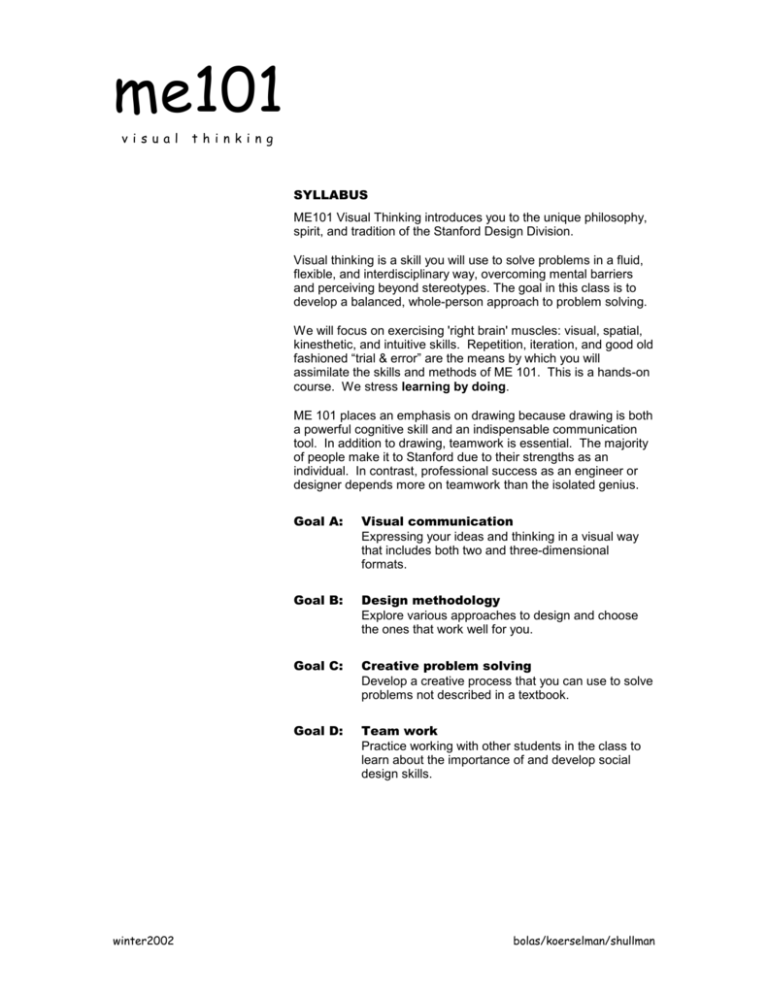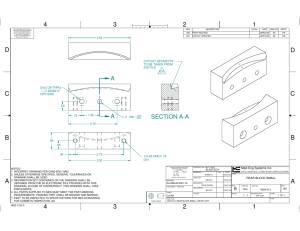visual thinking
advertisement

me101 visual thinking SYLLABUS ME101 Visual Thinking introduces you to the unique philosophy, spirit, and tradition of the Stanford Design Division. Visual thinking is a skill you will use to solve problems in a fluid, flexible, and interdisciplinary way, overcoming mental barriers and perceiving beyond stereotypes. The goal in this class is to develop a balanced, whole-person approach to problem solving. We will focus on exercising 'right brain' muscles: visual, spatial, kinesthetic, and intuitive skills. Repetition, iteration, and good old fashioned “trial & error” are the means by which you will assimilate the skills and methods of ME 101. This is a hands-on course. We stress learning by doing. ME 101 places an emphasis on drawing because drawing is both a powerful cognitive skill and an indispensable communication tool. In addition to drawing, teamwork is essential. The majority of people make it to Stanford due to their strengths as an individual. In contrast, professional success as an engineer or designer depends more on teamwork than the isolated genius. winter2002 Goal A: Visual communication Expressing your ideas and thinking in a visual way that includes both two and three-dimensional formats. Goal B: Design methodology Explore various approaches to design and choose the ones that work well for you. Goal C: Creative problem solving Develop a creative process that you can use to solve problems not described in a textbook. Goal D: Team work Practice working with other students in the class to learn about the importance of and develop social design skills. bolas/koerselman/shullman GRADING DP1/Logbook DP2/Logbook DP3/Logbook Homework, In-Class Effort 30% 30% 30% 10% We try to make your grade reflect the following: Progress/Improvement Participation Skill Success (Did it work?!!) Effort/Enthusiasm These things come through in the following components of grading: Design Projects (DPs) There are three major design projects. All will exercise your thinking skills and contribute to your intellectual understanding of visual thinking. Be forewarned: projects are time-intensive, especially just before they are due. The two largest construction projects happen during the first eight weeks of the course. The basic factors that influence the grading of these projects are: Quantity (fluency, practice, iteration, see also logbook) Quality (craftsmanship, “WOW” appeal, original thinking) Teamwork (peer grading) When we introduce each DP, specific grading criteria will be provided. Logbook(s) During the quarter you will keep a bound logbook(s). They are a critical record of your work throughout the quarter, especially as a document of your work on the design projects and other exercises. We evaluate much of your progress through what we find in your logbooks. Since improvement in skill level directly corresponds to the amount of practice, we look for sheer quantity and effort. Do most of your work in your logbooks. This includes: Brainstorming and Thought recording Problem solving Prototype development Extra drawing practice and exercises, etc. Homework Homework is structured to help you practice the skills we learn in class. The homework will reflect what needs to be done in your logbooks and help you create successful design projects! Your freehand drawing ability and idea-generating skills will improve only with lots of practice. Individuals who commit to extra practice will see the benefits. Format: Homework should be done on individual sheets of appropriate marker paper. Presentation and commitment count. Grading: Homework is generally posted on the walls and graded by the TA's during class. Late homework is not accepted during the quarter. Portfolio: Keep your homework stored neatly and cleanly in your portfolio, which we ask for along with your logbooks at the end of the quarter. winter2002 bolas/koerselman/shullman TEXT BOOKS No texts are required for the course. There are numerous excellent books from which the course draws and on related subjects that we are happy to recommend. Just ask. OFFICE HOURS Alex, Andrea, Mark, Hsiao-Yun and Brett are generally available to answer questions, give individual attention, provide feedback and help solve problems. Since we've had very little attendance at office hours in the past, we will schedule things a bit differently than normal. If you would like to talk, see one of us after class. Or call one of us to set up an appointment. Most questions and panic attacks occur near project due dates. We will announce the time and location of special office hours before those dates. CONTACT INFO winter2002 Mark Bolas 650.526-3972 work bolas@well.com Andrea Koerselman 650.289-3654 work andreak@ideo.com Alex Shullman 415.241-0441 work ashullman@yahoo.com Hsiao-Yun Chu 650.723.0326 loft hychu@stanford.edu Brett Newman 650.723.0326 loft bnewman@stanford.edu bolas/koerselman/shullman me101 visual thinking CLASS SCHEDULE @ A GLANCE* Tuesday Thursday JAN 08 INTRO TO ME101 JAN 10 INTRO TO DRAWING JAN 15 BRAINSTORMING, LOGBOOKS JAN 17 INTRO TO SEEING, FABULOUS FOAMCORE JAN 22 RELAXED ATTENTION, DRAWING JAN 24 DRAWING, PROTOTYPES JAN 29 QUICK DRAWING, IMPROV JAN 31 DESIGN PROJECT #1 PRESENTATIONS FEB 05 ADVANCED DRAWING FEB 07 ADVANCED DRAWING, MECHANISMS FEB 12 ADVANCED DRAWING, METHODOLOGIES FEB 14 ADVANCED DRAWING, METHODOLOGIES FEB 19 ADVANCED DRAWING FEB 21 METHODOLOGIES FEB 26 DESIGN PROJECT #2 PRESENTATIONS FEB 28 NEEDFINDING MAR 05 CONCEPTUAL BLOCK BUSTING, COLOR MAR 07 FIGURE DRAWING, IMPROV DANCE MAR 12 SYNECTICS, NON-VISUAL COMMUNICATION MAR 14 DESIGN PROJECT #3 PRESENTATIONS *We’ll keep you posted if anything changes. winter2002 bolas/koerselman/shullman







